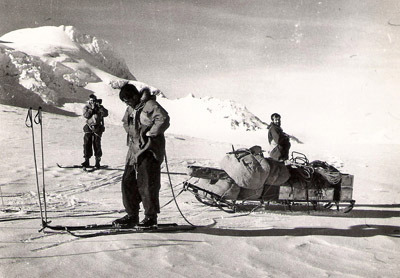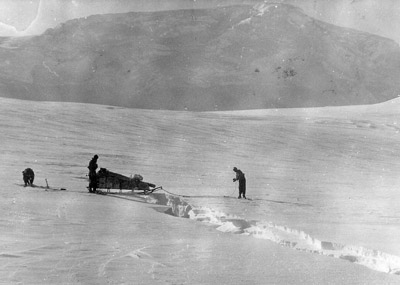Antarctic Holiday
Dave Edwards
manhauls sledges from Halley in 1960
Antarcticans Database
Project -
more
It was November, The Summer months were with us again and the sun was above the horizon for twenty-four hours each day. This was the midnight sun in the Southern Hemisphere. Our location on the map was 75° 31' South, 26° 36' West, situated at the south-eastern edge of the Weddell Sea.
Our home was on a huge ice-shelf. 600 ft. thick and covering an area of something in the region of 400 miles by 70 miles. Although this ice was floating on the sea, it was still attached to the land ice all along the coastline. Where the junction of the ice occurred there was a huge chasm, at times 150 ft. wide and abort the same in depth. In some places, however, it was completely filled in by the ice flowing down off the steeper parts of the land mass. As part of our work (or pleasure), four of us decided that we would make a reconnaissance of an area of the ice shelf where it was joined to the land ice. Then our main intention was to cross onto the land ice.
These are pictures of manhauling under
similar conditions from the same era,
they were not taken
on the journey described in the text here.
It was a sunny November 5th when we left our base; the temperature was minus 12°C. We travelled by man-hauling our own sledges. We had two men hauling each sledge, and enough food for a month. We also had on our sledges a utensil box and ice-axes and ropes and of course a tent to sleep in. Behind the sledge was a bicycle wheel with a meter to record our mileage.
We estimated that we had to travel 40 miles before we would reach the chasm, and as 12 miles a day is very good sledging, it would take us at least four days to get near the chasm. We also knew that there were waves in the ice shelf, the crests being two miles apart near our base, but about a hundred yards near the area of the chasm. This is caused by the great pressure on the ice.
After our first day of sledging we did about II miles over the almost flat ice shelf. The toil was indeed hard and although the temperature was well below freezing. point, we were perspiring quite freely. That night. and on subsequent nights, we were glad to get into our sleeping bags. have our meal and then to sleep.
The next morning grey skies greeted us. accompanied by a slight breeze. With the overcast sky we had a near total whiteout, which is quite disturbing as there are no shadows cast by the sun, the result being that one cannot see the surface one walks on. We managed to do four miles that day. One sledge went ahead, while the other stayed still. the sledge in front was taking back bearings with the compass on the one behind. This was quite wearisome.
By 1 p.m. the wind was up to 20 knots. and we were all quite dizzy with the whiteout, so we made camp. After a mug of hot soup, we settled down into our sleeping bags. This was an occasion when reading material was useful, so now I really had time to read "War and Peace."
The next morning, it was bright and windless, and the sun was so hot that we struck camp stripped to the waist. After an hour or so of sledging, we noticed that it was getting quite hard work. The ice shelf was now rolling up and down quite viciously. We started to pass huge holes in the ice, some 100 ft. deep, with walls of sheer blue ice.
By 6 p.m. that day we had done 12.5 miles, our best day yet. We estimated that we would be almost in striking distance of the junction chasm the next day.
Over a mug of cocoa that night, we decided that two of us would stay in tents, and two would go ahead to see what the terrain was like This was done on the following day and the two who had been out arrived back at 3 p.m. They reported that the terrain was quite good for the next three miles, but after that there were huge 45° folds in the ice and numerous crevasses. The place we were heading for was a large ice-fall coming down from the land ice. We presumed that it would help to fill the junction chasm in.
During the night, the wind got up to 50 knots, and by morning it was impossible to go anywhere. With the strong wind, there was considerable drifting, and it was like a thick white fog outside. Inside the tent it was quite snug, and our sleeping bags proved very warm. After 5 days, the wind went down, and we struck camp on the sixth morning. Soon the toil became very hard, with the sun glaring down through the clear blue sky. After three miles, we came across our first crevasses, so we had to watch where we put our feet. We were soon hauling our sledges up and down slopes of 45° or more.
It became quite tricky when we had to cross patches of hard blue ice. By 5 p.m. we had covered nearly 6 miles. and were well pleased with our day's effort. We knew we were nor very far from the junction chasm. so next morning we went straight ahead on foot, heading in the direction of the huge ice-fall. which now looked like the step of a giant's staircase. Alter an hour or two when we were virtually at the foot of the ice fall, we saw the great chasm that we had been looking for, over a crest of an ice hillock. To the West as far as the eye could see, the great chasm stretched out. To the East, however, the ice fall had filled the chasm in so we were well pleased with our assumptions. We then headed towards the area that was filled in and crossed over onto the land ice, which had been our objective.
Then we set about the task of finding a good route for our sledges. This proved quite difficult, and we finally found out that we would have to go four times the distance with sledges. Going back to our camp, we had our first mishap. While descending a snowy slope, I went through a crevasse about four feet wide. For a moment my heart was in my mouth. I flung myself forward and, by great good luck, bridged the crevasse. My companions came quickly to my help, and dragged me out of an awkward situation. We finally arrived back at our tents a little worse for wear, but looking forward to the next day.
This was quite cool, with a fair amount of cloud. We struck camp and were away by 10 a.m. Soon we were on very slippery blue ice, and had great difficulty in controlling our sledges. All went well, however, and by lunch time we were near the great chasm. While having lunch, we were startled by noises like artillery fire. It was quite alarming, but we then realised it was the movement of the ice under us.
After lunch we pressed on and were soon crossing the snow bridge and the land ice. We were very pleased with ourselves, and after the usual photos decided to try to explore 10 miles further in on the land ice. The sledging for that, day and the one following, was very hard. There was a steady gradient against us all the time; no sooner had we got to the top of a crest, than another appeared above us.
We camped for a day when we were 10 miles inland, and marked our position on the map we were making. We were about 2,400 above sea level, and could see the vast expanse of the ice shelf in front of us. We could pick out ice crevasses.
The following day decided to start our return to base The first 10 miles were quite hectic. We sat on the sledges and let them slide downhill. steering with our feet. and having a rope ready to sling under the runners when we wanted to stop. That night we camped in the area of the chasm. Because of bad visibility, we had to have two nights there. Such a cracking and banging went on all the time from the ice that we wondered if the whole lot was breaking up. However, the weather improved, and we were glad to be away from such an area. All that we had to do now was to get out of this chaos of ice and head back to our base.
About this time we had an amazing period of sunshine. The sun just floated around the sky with never a cloud crossing it, for 150 continuous hours. Surely a record! By this time, we were well and truly sunburned; our noses, in particular were well cooked.
After a few more days of uninteresting travel over the flat ice-shelf, we arrived back at base, no worse for wear and highly pleased to have a good bath, and a change of food. It was with a feeling of great contentment that I curled up in my own comfortable bed that night.
DAVE EDWARDS


